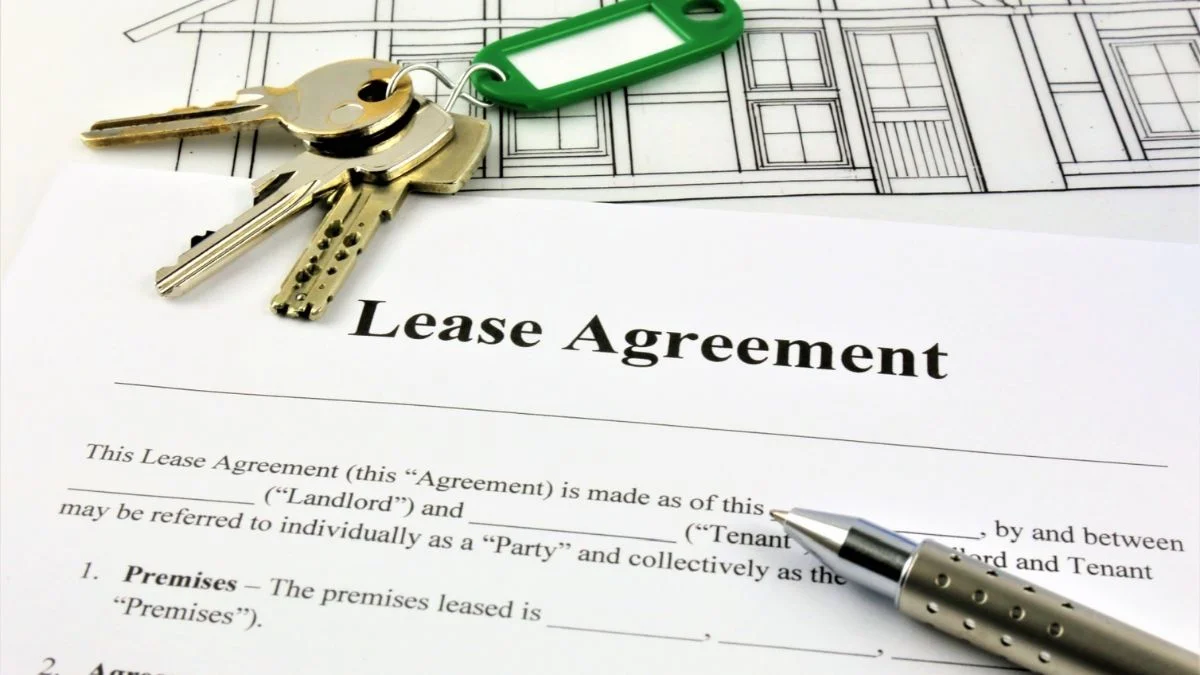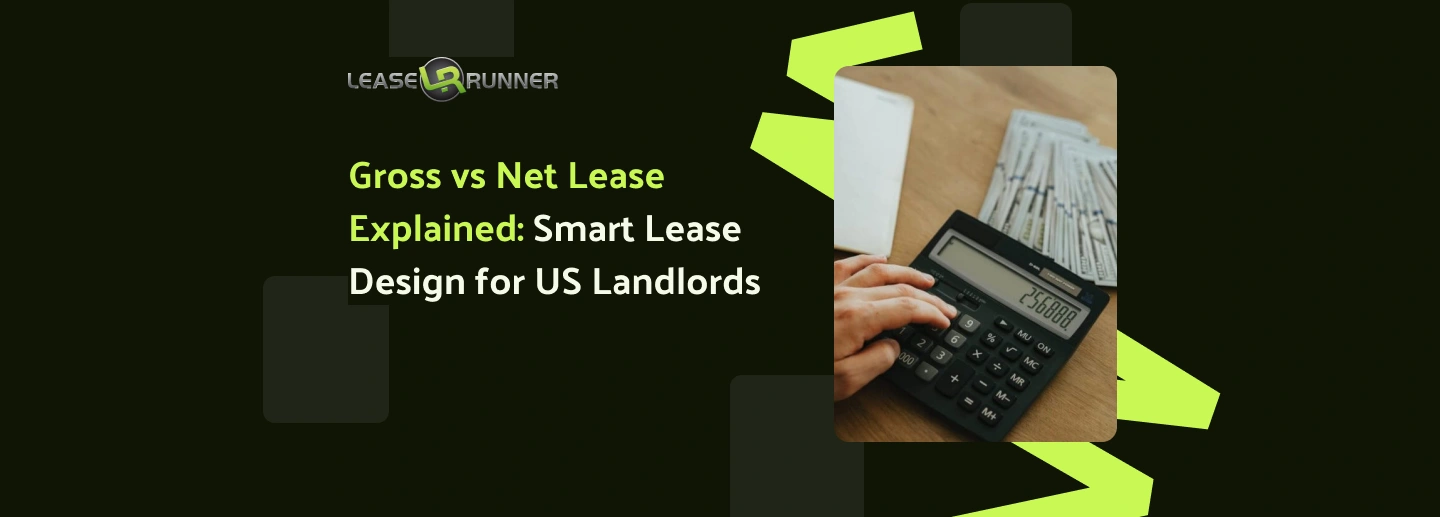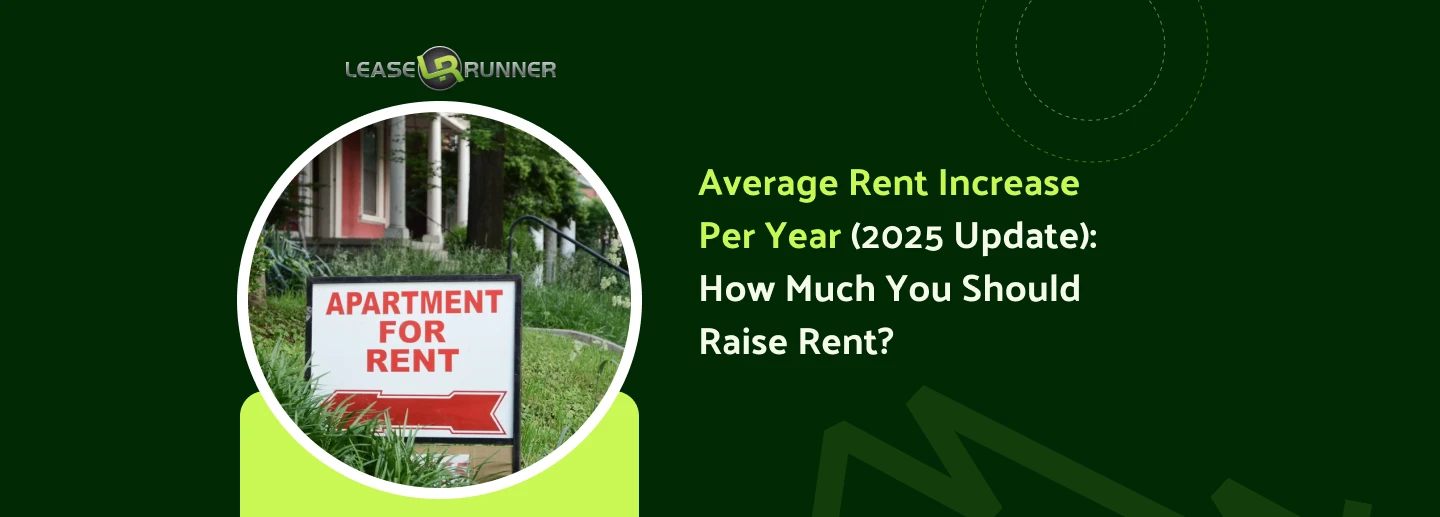Leasing structures can feel like a maze for many landlords. In the U.S., two of the most common frameworks are gross lease and net lease. Choosing the right one affects your cash flow, maintenance obligations, and even tenant relationships.
In this guide, we’ll break down net rent vs gross rent, provide real-world examples, and explain legal considerations so you can design smarter leases.
Overview Of Gross and Net Lease in Real Estate
In simple terms, a lease is a legal contract between a landlord and a tenant, but the terms “gross lease” and “net lease” relate specifically to how operating costs are allocated. In real estate, gross rent and net rent describe the amount a tenant pays before or after deducting expenses, while gross lease and net lease define the type of lease structure that determines who covers those expenses.
In most cases, a net lease arrangement results in the tenant paying net rent along with certain operating costs, whereas a gross lease typically bundles those costs into a single rent payment. Understanding these distinctions is essential for setting clear terms and protecting your rental property cash flow.

What Is Gross Rent?
If you’re wondering what is gross rent in legal terms, many state lease statutes simply define it as the “total consideration paid by the tenant for the use and occupancy of premises,” without breaking down individual expenses.
Gross rent is the total amount a tenant pays for renting a property, which includes the base rent plus additional costs such as utilities (water, electricity, gas), maintenance fees, and sometimes other expenses like property taxes or insurance, depending on the lease type. Under a gross lease, this becomes a single, all-inclusive payment. You, the landlord, are responsible for covering most of the property's operating costs.
Imagine you rent out a small office for $3,000 per month under a gross lease. That amount already covers building maintenance, property insurance, and real estate taxes. The tenant just pays the $3,000—no surprises.
What Is Net Rent?
Net rent is the amount a tenant pays under a net lease. In this type of agreement, the tenant pays a fixed base rent at the start of each period, but that amount does not include property outgoings. Instead, the tenant is responsible for covering additional expenses such as:
- Maintenance and repairs
- Real estate taxes
- Insurance premiums
- Water rates
- Management fees
- Strata levies
In some cases, net rent is favorable for property owners because their tenants must be responsible for paying some or all of the property's operating expenses, such as property taxes, insurance, utilities, or maintenance, on top of that base rent. This type of lease is especially common in commercial real estate, where operating costs are itemized and passed directly to the tenant.
So, what is net rent in practice? If you lease a warehouse at $3,000/month net rent, and the tenant covers $500 in taxes and $200 in insurance, your gross rent becomes $3,700. You collect the base rent while separately tracking and billing the additional costs.
In conclusion, understanding the difference between net rent vs gross rent is vital for both landlords and tenants, as it shapes lease terms, influences expense allocation, and ultimately affects long-term rental property cash flow.
Net Effective Rent vs Gross Potential Rent
These two terms are related but serve different purposes in evaluating a property’s performance. Gross potential rent is the total rental income you could collect if the property were 100% occupied and every tenant paid in full, essentially the “perfect scenario” figure.
Net effective rent, on the other hand, reflects the actual amount a landlord earns after subtracting rent concessions, such as a month of free rent, discounted rates, or other incentives offered to tenants (learn more about rent concessions here). This gives a more accurate picture of true income, especially in competitive rental markets where concessions are common.
For example, if the advertised rent is $2,000/month but you offer one month free on a 12-month lease, the tenant effectively pays $22,000 for the year. Dividing that by 12 months results in a net effective rent of about $1,833/month.

When weighing net rent vs gross rent, it helps to see the distinctions side by side. Let's check it out on the table below:
The most significant difference between gross and net rent is who bears the financial risk of fluctuating expenses. With a gross lease, an unexpected spike in property taxes hits your bottom line directly. With a net lease, that burden is passed on to the tenant. This is the core contrast in net rent vs gross rent.
How to Calculate Gross Rent and Net Rent?
Understanding the math behind your income is essential when comparing net rent vs gross rent. Let’s walk through how to calculate gross rent and net rent with practical examples.
Gross Rent Calculation Formula
From a landlord’s point of view, gross rent is the total amount received from a tenant, including the base rent plus any operating expenses that the landlord covers. The formula is straightforward:
Let’s look at a practical example:
Sarah owns a small office building. She charges her tenant a base rent of $2,500 per month. Additionally, she pays $500 each month for property taxes, insurance, and maintenance. Because these costs are included in the lease as part of a gross lease, the tenant pays a flat monthly rent of $3,000.
For Sarah, this $3,000 represents the gross rent - the total income she receives before subtracting any expenses. For the tenant, it means a predictable, all-in monthly payment without unexpected extra charges.
Net Rent Calculation Formula
To understand your true profit, you need to calculate your net rental income.
In a net lease, the calculation is even simpler:
Because the tenant pays the operating expenses separately. This is why the difference between gross and net rent is so important for your financial clarity. When you calculate net free rent vs gross free rent, remember to account for any tenant concessions, as this affects the actual income you receive.
For example:
Alex leases his retail store under a triple net (NNN) lease. The tenant pays $1,800 in base rent monthly, plus their share of property taxes, insurance, and maintenance costs directly. James does not cover any of these expenses.
Here, Alex ’s net rent is $1,800 per month—the base rent he receives without any deductions, because operating costs are paid by the tenant.
Types of Lease Structures Landlords Should Know

Beyond the simple distinction between gross and net leases, there are several lease variations every landlord should understand. Knowing these options helps you tailor lease agreements to fit your property type, tenant profile, and financial goals.
1. Gross Lease (Full-Service Lease)
In a gross lease, the landlord covers all or most operating expenses, including taxes, insurance, and maintenance. This lease is straightforward and popular in residential and small office settings.
Let's imagine, a landlord renting out a 10-unit apartment building charges tenants a flat $1,200/month. This rent includes property taxes, building insurance, and maintenance like landscaping. Tenants pay no additional fees beyond rent, making budgeting simple.
2. Modified Gross Lease
A modified gross lease is a hybrid. The landlord and tenant agree on a fixed expense base. If operating costs rise above that amount, the tenant pays a proportional share of the increase. This provides a balance of predictability and shared responsibility.
3. Net Lease
Net leases require tenants to pay a portion of the property’s operating expenses, reducing the landlord’s exposure to fluctuating costs.
- Single Net Lease (N Lease): Tenant pays base rent plus property taxes. The landlord usually handles insurance and maintenance.
- Double Net Lease (NN Lease): Tenant covers property taxes and insurance, while the landlord typically manages structural maintenance.
- Triple Net Lease (NNN Lease): The tenant pays for property taxes, insurance, and all maintenance costs—both structural and non-structural. This is the most common net lease in commercial real estate.
4. Absolute Net Lease
This is a more extreme form of the triple net lease. The tenant assumes all responsibilities, including major structural repairs and even roof replacement. Landlords benefit from minimal management but must carefully vet tenants.
5. Percentage Lease
Often used in retail leases, a percentage lease combines a base rent with a percentage of the tenant’s gross sales. This aligns landlord income with tenant business performance. For example, a popular fast-food chain rents a space with a base rent of $5,000/month plus 5% of monthly gross sales exceeding $100,000. This aligns landlord income with tenant sales performance.
6. Variable Lease
A variable lease adjusts rent over time according to a pre-set formula or index—like inflation or sales volume - offering flexibility for both parties.
How Gross vs Net Lease Affects Landlords?

Your choice of lease structure has a profound impact on your business. Let's look at the key areas affected.
Financial Risk and Operating Expenses
With a gross lease, you shoulder all the risk of rising costs. For instance, unless you can increase the rent when the lease renews, your profit margin will decrease if your property insurance premium unexpectedly increases. A triple net lease, on the other hand, transfers this risk to the tenant, giving you more steady, predictable revenue.
Cash Flow Predictability
A net lease frequently excels in this situation. You can more precisely predict your net rental income because the tenant bears the variable operating costs. This is particularly helpful for money management and investment planning. Because operating expenses can change suddenly under a gross lease, your net rental income is less predictable.
Access to our full-guide on How to pay no taxes on rental income help you pay less!
Management and Maintenance Responsibility
A gross lease frequently indicates that you are a more involved landlord, handling service provider management and maintenance requests. Since the tenant is in charge of these daily duties, a net lease, especially a triple net lease can be considerably more passive.
Potential Returns and Rent Escalation
A net lease frequently offers a more stable, albeit possibly lower, net income, whereas a gross lease might offer a higher potential gross rent. In order to stay up with inflation and growing expenses, lease escalation clauses which permit rent increases over time are essential in both kinds of leases.
Ease of Lease Transfer
Net leases, especially NNN leases, are often easier to sell to investors because of their predictable income stream and passive management requirements.
Legal Considerations for US Landlords

Having legal waters is crucial for all landlords. A well-drafted lease is your best defense against disputes.
State and Local Lease Law Differences
Lease laws differ widely from state to state and even between cities within the same state. For instance, Texas allows landlords to charge late fees and set security deposit limits with relatively flexible rules. But in California, Civil Code §1950.5 strictly limits security deposits and requires specific handling and refund procedures.
In New York City, local rent stabilization laws impose additional tenant protections that supersede state law. For example, landlords there must comply with rent control regulations that limit rent increases and eviction grounds.
Required Lease Clauses for Expense Allocation
For a net lease to be enforceable, your lease must clearly define which expenses the tenant is responsible for. This includes specific language about taxes, insurance, and maintenance. Vague wording can lead to costly legal battles.
For example, a commercial landlord in Chicago had a net lease that stated tenants would pay “a reasonable share of property expenses.” When property taxes spiked, tenants disputed what counted as “reasonable.” Because the lease lacked specificity such as itemizing taxes, insurance, and maintenance, the landlord faced a prolonged legal dispute and lost part of the additional charges.
Avoiding Hidden Charge Disputes and Fair Housing Compliance
Be transparent about all fees and charges. Unclear or "hidden" fees can lead to disputes and violate consumer protection laws. Also, the Fair Housing Act (FHA) prohibits discrimination based on race, color, religion, sex, familial status, national origin, or disability. Landlords must ensure that their lease terms, fee structures, and tenant screening policies comply with FHA requirements.
Smart Lease Design Strategies for Landlords

Choosing a lease type is just the beginning. Smart design can optimize your returns and minimize your workload. Here are key strategies to consider when crafting your lease agreements.
Choosing Between Gross and Net Lease Based on Property Type
- Gross Lease: Best suited for residential properties where tenants prefer the simplicity of a single, all-inclusive monthly payment.
- Net Lease (especially NNN): Ideal for commercial properties, single-tenant buildings, and investors seeking passive income. This lease type shifts many operating expenses such as property taxes, insurance, and maintenance onto the tenant, reducing the landlord’s workload and providing more predictable, stable rental property cash flow. For long-term commercial tenants, especially in single-tenant arrangements, a net lease can also lower management costs and mitigate financial risks from variable operating expenses.
Negotiating Expense Caps and Maintenance Terms
In a modified gross lease, it's smart to negotiate an expense cap. This cap limits how much the tenant pays for operating expense increases, shielding both parties from unexpected cost surges.
In net leases, the lease should clearly spell out maintenance responsibilities. For example, specify who is responsible for routine plumbing repairs versus who must replace major systems like HVAC units. Clear definitions prevent disputes and keep your property well maintained.
Using Lease Clauses to Protect Cash Flow
Lease clauses are specific terms written into a rental agreement that define rights, responsibilities, and procedures for both landlord and tenant. Well-crafted clauses not only clarify expectations but also help prevent income loss and legal disputes.
To safeguard your income:
- Include clauses requiring timely rent payments.
- Set penalties for late payments or bounced checks.
- Outline a clear process for handling missed payments or disputes.
- Consider using an online platform to collect rent securely, which reduces delays and helps maintain steady cash flow.
Lease Renewal and Rent Adjustment Clauses
Inflation and rising operating costs can eat into your profits over time. Always include a rent escalation clause to adjust rent annually or at agreed intervals. This clause helps ensure your rental income keeps pace with market conditions, maintaining your investment’s value.
Conclusion
The debate of net rent vs gross rent isn’t about one being inherently better than the other. It's about choosing the right tool for the job. A gross lease offers simplicity and predictability for tenants, making it perfect for residential properties. A net lease, especially a triple net lease, offers stability and passive income for landlords, making it the preferred choice for many commercial ventures.
No matter which structure you choose, managing leases and collecting rent can be a hassle. That’s why smart landlords use LeaseRunner. Our platform streamlines lease management, making it easy to draft custom agreements and collect rent online securely. Don't let property management stress you out.
FAQs
Does 3x Rent Mean Gross or Net?
Yes, it almost always refers to gross rental income. When landlords ask for an income of "3 times the rent", they are typically talking about a tenant’s total pre-tax income, not their net (after-tax) income. The purpose is to ensure that the tenant’s earnings are high enough to comfortably cover the monthly rent payment while still affording other living expenses.
When Should a Landlord Choose Net Lease Over Gross Lease?
A landlord should choose a net lease when they want a more hands-off investment with predictable net or gross rental income. This structure is ideal for commercial properties, where tenants often have a vested interest in maintaining the property.
What Is Net Rental Income?
Net rental income is your profit after all expenses have been deducted from the rent you collect. This includes everything from mortgage payments and property taxes to maintenance costs and vacancy losses.




![What Is an Admin Fee for Apartments? [2025 Landlord’s Guide]](https://www.leaserunner.com/storage/413/01KAJSZKW3TMYDTGTKJV8VHGPN.webp)


